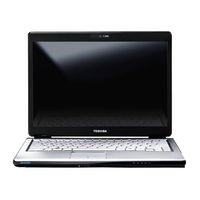TOSHIBA Satellite Pro A200 Series Manuals
Manuals and User Guides for TOSHIBA Satellite Pro A200 Series. We have 4 TOSHIBA Satellite Pro A200 Series manuals available for free PDF download: User Manual
Toshiba Satellite Pro A200 Series User Manual (232 pages)
Portable Personal Computer
Table of Contents
-
Conventions
32-
Icons32
-
Keys32
-
Display33
-
Messages33
-
Terminology33
-
Heat Injury
35 -
Mobile Phone
36 -
Features
39 -
Options
52 -
Left Side
55 -
Right Side
56 -
Back Side
57 -
Underside
58 -
-
AV Button61
-
-
AC Adaptor
67 -
-
-
Video107
-
Media Care
111 -
Modem
114-
Region Selection115
-
Properties Menu116
-
-
Lan
120 -
Heat Dispersal
123 -
Typewriter Keys
125 -
-
Hot Keys127
-
Fn Sticky Key130
-
Keypad Overlay
130 -
Power Conditions
133 -
Power Indicators
135-
DC in Indicator135
-
Power Indicator136
-
Battery Types
136-
Battery136
-
-
-
Power-Up Modes148
-
Hot Keys148
-
System Auto off148
-
-
HW Setup
149-
HW Setup Window149
-
User Password150
-
Power on Display151
-
Boot Priority152
-
-
-
Cards/Memory155
-
Power Devices155
-
Other155
-
-
PC Cards
156 -
Express Card
158 -
Memory Expansion
163 -
USB FDD Kit
166 -
External Monitor
166 -
Television
167 -
-
Precautions168
-
Connecting168
-
Disconnecting169
-
Security Lock169
-
-
-
System Start-Up173
-
Self Test174
-
Power174
-
Password177
-
Keyboard177
-
LCD Panel177
-
Hard Disk Drive178
-
Diskette Drive182
-
Pointing Device182
-
USB Mouse183
-
PC Card186
-
Express Card186
-
Monitor187
-
Sound System188
-
TV Output Signal188
-
Usb189
-
Modem189
-
Lan191
-
Wireless LAN191
-
Bluetooth192
-
-
TOSHIBA Support
193-
Before You Call193
-
-
Cpu
195 -
Battery Life
196 -
Lcd
197 -
Copy Protection
198 -
Images
198 -
Appendixes
199 -
Appendix B
203-
Video Modes204
-
-
Appendix C
205-
United Kingdom214
-
Cache Memory218
-
Write Protection227
Advertisement
Toshiba Satellite Pro A200 Series User Manual (237 pages)
A200-EZ2204X User's Guide
Table of Contents
-
Introduction33
-
This Guide34
-
Safety Icons35
-
-
-
-
Traveling Tips113
-
-
-
TOSHIBA Assist131
-
Connect132
-
Secure133
-
Protect & Fix134
-
Optimize135
-
-
Fn-Esse144
-
Starting Fn-Esse144
-
-
Mouse Utility148
-
-
-
-
A Plan of Action160
-
Memory Problems163
-
Display Problems166
-
Printer Problems174
-
Modem Problems175
-
-
-
Volume Mute189
-
Power Profile191
-
Standby Mode192
-
Hibernation Mode192
-
Display Modes193
-
-
-
Computer197
-
Toshiba Computer197
-
Getting Started198
-
-
Profile Settings207
-
Quick Connect213
-
Glossary217
-
Index231
-
TOSHIBA Satellite Pro A200 Series User Manual (222 pages)
TOSHIBA Satellite A200/Satellite Pro A200 Series Portable Personal Computer
Table of Contents
-
Fax Branding19
-
Preface
32 -
-
-
Lan93
-
Wireless LAN94
-
Media Care103
-
Discs103
-
TV-Out & HDMI104
-
-
Summary107
-
Disc Recording120
-
-
-
Power Conditions137
-
Power Indicators139
-
Battery Types140
-
Power-Up Modes150
-
-
-
HW Setup Window151
-
Boot Priority153
-
-
-
Express Card156
-
Memory Expansion160
-
External Monitor164
-
Television164
-
Hdmi167
-
Security Lock178
-
-
-
-
Self Test182
-
Lcd Panel185
-
Hard Disk Drive186
-
Sound System188
-
Pointing Device188
-
Usb Mouse189
-
Tv Output Signal190
-
Disk Drive195
-
Real Time Clock195
-
-
TOSHIBA Support197
-
Where to Write198
-
-
Cpu199
-
Battery Life200
-
Lcd201
-
Wireless LAN201
-
Copy Protection202
-
Images202
-
Advertisement
Toshiba Satellite Pro A200 Series User Manual (188 pages)
Table of Contents
-
Fax Branding19
-
Preface
32 -
-
-
Lan81
-
Wireless LAN82
-
Media Care99
-
Discs99
-
TV-Out100
-
-
Power Conditions109
-
Power Indicators111
-
Battery Types112
-
Power-Up Modes122
-
-
-
HW Setup Window123
-
Boot Priority125
-
-
-
Express Card128
-
Memory Expansion133
-
Battery Charger136
-
External Monitor136
-
Television137
-
Security Lock143
-
-
-
-
Self Test148
-
Lcd Panel151
-
Hard Disk Drive152
-
Sound System154
-
Pointing Device154
-
Usb Mouse155
-
Tv Output Signal156
-
Disk Drive160
-
Real Time Clock161
-
-
TOSHIBA Support162
-
Where to Write163
-
-
Cpu165
-
Battery Life166
-
Lcd167
-
Wireless LAN167
-
Copy Protection168
-
Images168
-
Advertisement
Related Products
- Toshiba Satellite Pro A200-T03
- Toshiba Satellite Pro A210 Series
- Toshiba Satellite Pro A215 Series
- Toshiba Satellite Pro A205 Series
- Toshiba Satellite Pro A10 series
- Toshiba Satellite Pro A100-00Y
- Toshiba Satellite Pro A100-501
- Toshiba Satellite Pro A660D Series
- Toshiba Satellite Pro A300 Series
- Toshiba Satellite Pro A65



